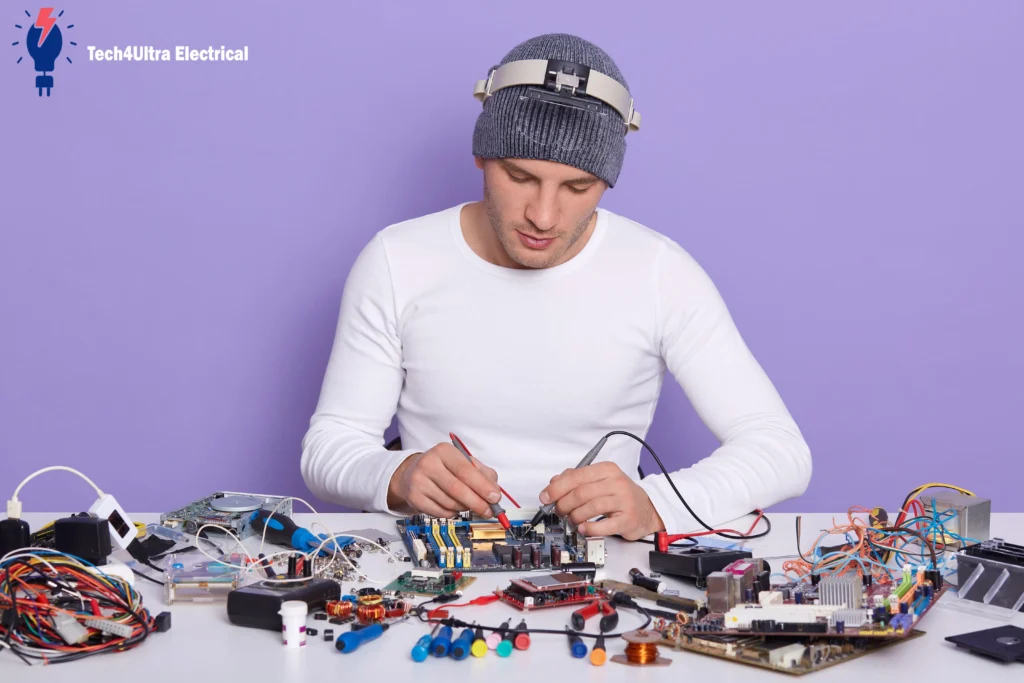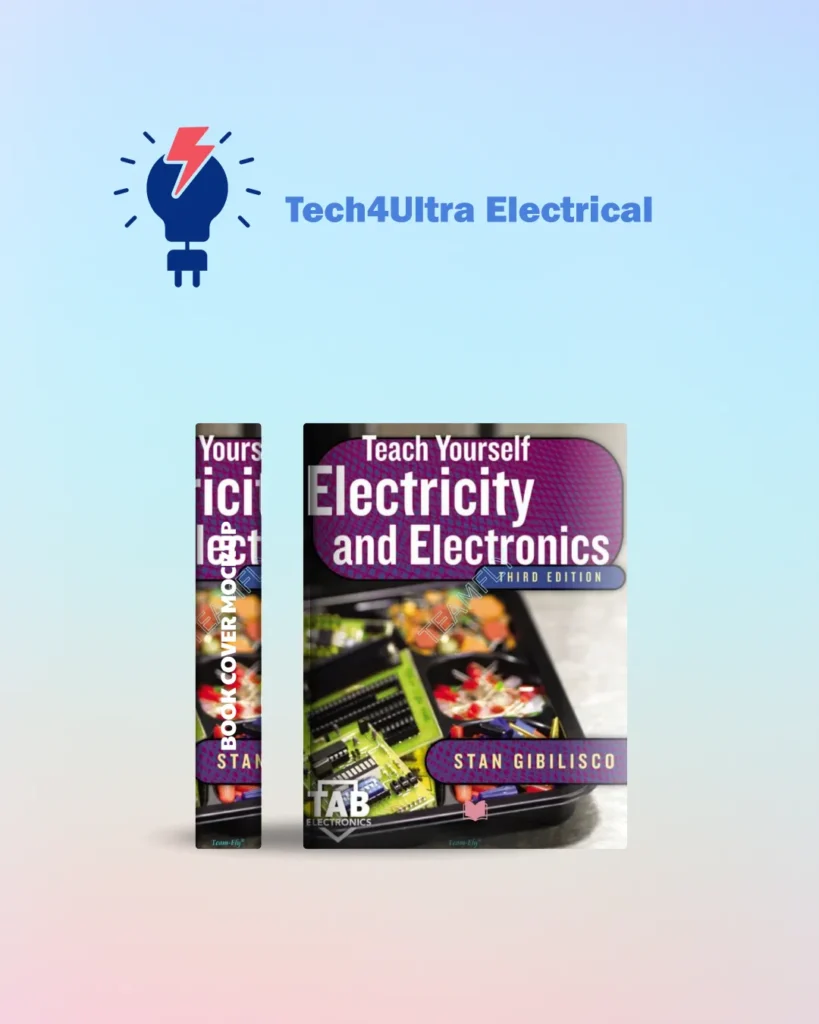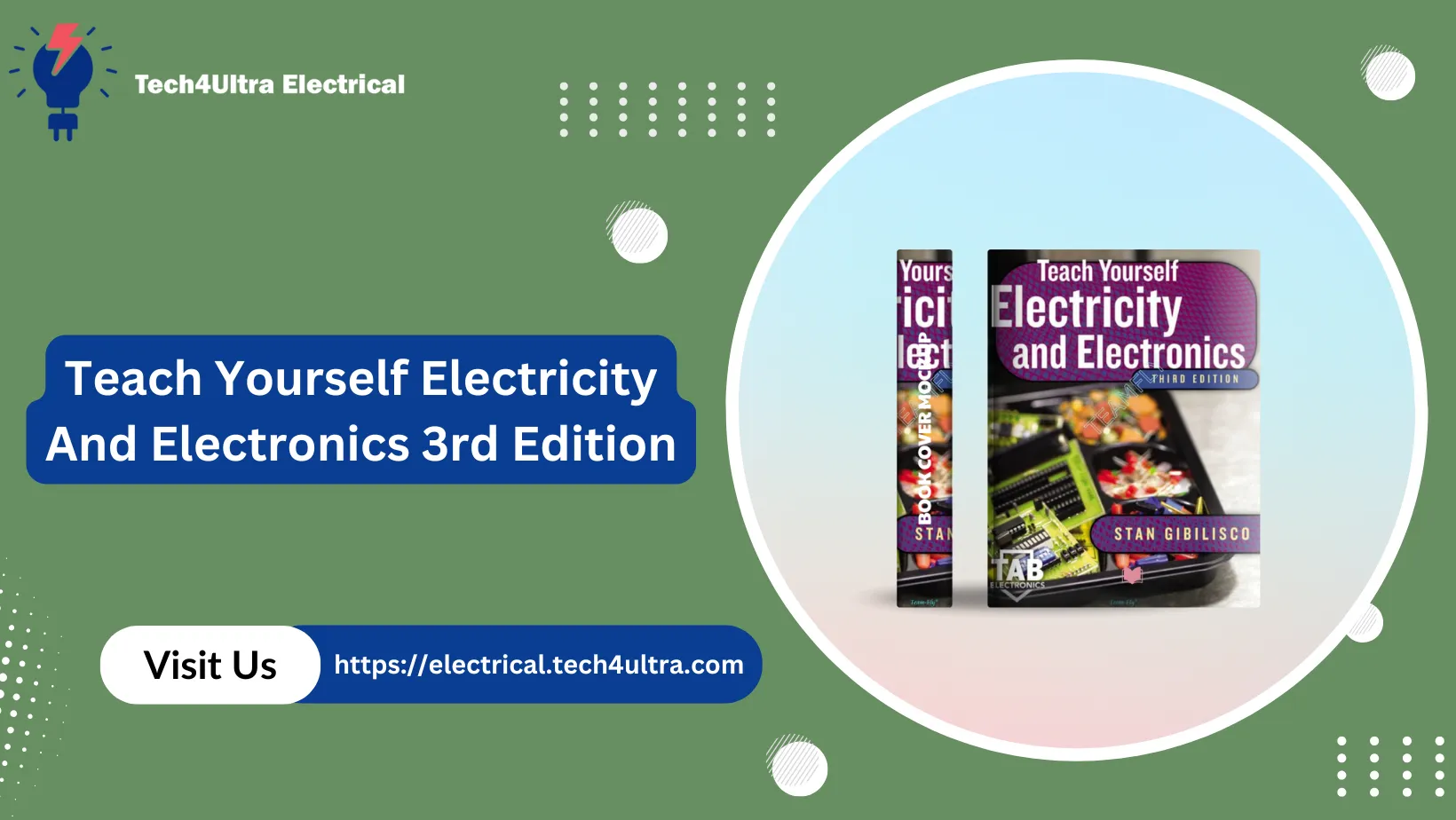Contents
In an era where smart homes, electric vehicles, and wearable tech are becoming everyday staples, understanding electricity and electronics is no longer just a luxury for engineers—it’s a necessity for anyone curious about how the modern world ticks. Whether you’re troubleshooting a malfunctioning circuit board or simply want to understand how your gadgets work, the basics of electrical science can open up a world of possibilities.
That’s where “Teach Yourself Electricity and Electronics” comes in—a book that has become a staple for students, hobbyists, and professionals alike. Written by the late Stan Gibilisco, a renowned science author, this guide breaks down complex concepts into digestible lessons, combining theory with hands-on examples. Over the years, it has empowered countless readers to grasp the fundamentals of electrical circuits, digital logic, and microcontrollers without needing a formal education in engineering.
For students, it’s a reliable supplement to coursework. For hobbyists, it’s a DIY handbook. And for professionals looking to refresh their knowledge, it’s a compact and clear reference. More than just a textbook, it’s a mentor in print.
So if you’re looking to dive into the world of electronics or brush up on your electricity basics, this book might just be your perfect starting point.

Why Learn Electricity and Electronics Today?
Learning electricity and electronics today isn’t just about understanding how your phone charges or why the lights flicker—it’s about unlocking opportunities. In a world driven by technology, having a grasp of electrical and electronic systems can lead to real, tangible career advantages. From robotics and automation to green energy and smart infrastructure, professionals with these skills are in high demand across industries.
Beyond the job market, there’s a practical benefit in daily life. Knowing how to fix a blown fuse, install a smart thermostat, or repair a faulty circuit board gives you independence. It’s empowering to troubleshoot and solve problems yourself, especially in a tech-heavy world where even your refrigerator might be connected to Wi-Fi.
The influence of electronics is everywhere—from the computer you’re reading this on, to the medical equipment that saves lives. Our cars are no longer mechanical beasts but electronic ecosystems. Homes are evolving into intelligent environments. The deeper your understanding of electricity and electronics, the more fluent you become in the language of modern life.
Books like Teach Yourself Electricity and Electronics by Stan Gibilisco make this journey approachable. They simplify the complexity, making it possible for anyone—from total beginners to seasoned tinkerers—to learn something new and potentially life-changing.
What Makes This Book a Must-Have Learning Resource?
When it comes to mastering the basics of electricity and electronics, not all books are created equal. What sets Teach Yourself Electricity and Electronics apart is the unique voice and teaching style of its author, Stan Gibilisco. Known for making complex scientific ideas surprisingly digestible, Gibilisco created a guide that feels less like a textbook and more like a helpful conversation with a seasoned mentor.
The structure of the book is one of its greatest strengths. It’s laid out in a way that doesn’t intimidate beginners but still provides depth for those with some background. Every chapter builds logically on the previous one, making it easy to follow whether you’re learning for the first time or brushing up after years away from the subject. Even better, the explanations are written in clear, straightforward language—no engineering degree required.
One standout feature is its focus on self-paced learning. You’re never rushed, and the book encourages you to take your time with each concept. Add to that the wealth of illustrations, diagrams, and practical examples, and you get a fully immersive learning experience. There are also hands-on exercises that guide you to actually build or test circuits—perfect for learners who need to “do” in order to understand.
Whether you’re a student preparing for a technical course, a hobbyist trying to build your first project, or someone simply curious about how things work, this book makes learning electronics and electricity both engaging and achievable. It’s not just informative—it’s empowering.
Core Concepts Explained Simply
One of the best things about Teach Yourself Electricity and Electronics is how it simplifies the stuff that usually makes people’s eyes glaze over—like voltage, current, resistance, and Ohm’s Law. These are the foundations of everything in electricity and electronics, and this book makes sure you actually understand them before moving forward.
Let’s start with voltage. Think of it like water pressure in a hose. It’s the force that pushes electricity through a wire. Without pressure, the water won’t flow—and without voltage, there’s no current.
Current is the flow itself—the amount of electricity moving through a circuit, similar to the amount of water flowing through that hose. It’s measured in amperes (amps), and it tells you how much energy is passing through the system at a given time.
Then there’s resistance. Imagine you’re trying to push that water through a narrow pipe. It’s harder, right? Resistance works the same way in electrical circuits—it slows the current down. Materials like copper have low resistance, while rubber has high resistance and actually stops current altogether.
Now, here comes the magic equation: Ohm’s Law. It’s the golden rule of electricity that links all three: voltage (V), current (I), and resistance (R). It’s written as V = I × R. Once you get this, you can calculate how much power a circuit needs or how much it will produce. It’s the key to not frying your components—or your fingers.
Stan Gibilisco uses real-world analogies like these throughout the book. He doesn’t just throw formulas at you—he helps you visualize and apply them. That’s why even complete beginners can start to “see” how circuits work in their mind before they ever touch a wire.
This friendly, grounded approach makes electricity and electronics feel less like rocket science and more like something you can actually figure out—one clear step at a time.

Inside the Book: Key Chapters and Learning Flow
What makes Teach Yourself Electricity and Electronics so effective is how well it’s organized. Stan Gibilisco didn’t just dump a bunch of technical info into a book—he laid out a learning journey. Each chapter has a purpose and builds on what came before it, guiding you from total beginner to someone who can read a circuit diagram with confidence.
It all starts with the basics: electricity and electronics at their core. The first chapters cover simple concepts like voltage, current, and resistance. These are the roots, and if you don’t get them, you’ll struggle later—so the book spends time making sure they’re clear.
Next, you move into components—resistors, capacitors, inductors, and diodes. Think of these as the building blocks. You’ll learn what they do, how they behave, and how to use them in circuits. By this point, you’ll start recognizing parts inside your own devices.
The book then dives into more advanced topics like AC and DC circuits, amplifiers, oscillators, and digital logic. Each chapter adds a layer of understanding. You don’t jump into microcontrollers or transistors without a foundation—it all comes gradually, with examples and simple tests along the way.
One of my favorite parts is the hands-on problem-solving sections. These aren’t just quizzes—they help reinforce each concept with real application. Gibilisco knew that you learn better by doing, not just reading.
Later chapters explore radio frequency circuits, power supplies, and even basic microprocessor theory. These areas might seem overwhelming at first, but thanks to the step-by-step flow, they feel like a natural progression.
By the time you reach the end, you’ll realize you’re no longer just learning electronics—you’re thinking like an electronics technician. That’s the real power of a book structured to teach, not just to inform.
Hands-On Learning: Projects and Practical Exercises
If there’s one thing that sets Teach Yourself Electricity and Electronics apart, it’s the emphasis on doing, not just reading. Stan Gibilisco knew that the best way to learn electricity and electronics is by getting your hands a little dirty—testing ideas, building simple circuits, and sometimes even making mistakes.
Throughout the book, you’ll find real DIY projects that walk you through the basics. Think simple resistor-capacitor circuits, basic amplifiers, or light-sensitive switches. These aren’t theoretical; they’re practical, safe, and totally doable even if all you have is a breadboard, a handful of components, and a multimeter.
There are also troubleshooting challenges—“What’s wrong with this circuit?”—that push you to think critically. Instead of just giving you the answers, the book encourages you to test and verify. It’s a fun, rewarding way to build real-world skills that will stick.
One of the coolest parts is how the exercises evolve. You don’t start by building a radio; you start by lighting an LED. Then you build up—step by step—until the more complex stuff starts to feel manageable. It’s learning by layering, not leaping.
And don’t worry about making mistakes. In fact, the book sort of expects it. It encourages you to experiment, tweak, and see what happens when you change a resistor or flip a diode the wrong way. That’s how confidence grows—by learning from both success and failure.
If you’ve ever wanted to actually build something and understand how it works, not just copy diagrams off the internet, this is where you start. The hands-on approach makes electricity and electronics come alive.
Supplementing Your Learning: Best External Resources
While Teach Yourself Electricity and Electronics by Stan Gibilisco gives you a rock-solid foundation, sometimes you need a little extra help or a different angle to fully grasp a concept. Luckily, the internet is packed with great resources that complement the book beautifully.
For structured courses, check out MIT OpenCourseWare and Khan Academy. Both offer high-quality, free content that explains electricity and electronics concepts in depth—perfect for reinforcing what you’ve read. Coursera is another solid option, especially if you’re looking for certificate-based learning or more hands-on assignments.
Sometimes, though, nothing beats a visual explanation. That’s where YouTube tutorials come in. Channels like ElectroBOOM, Afrotechmods, and EEVblog are entertaining and educational. They break down tough topics and show real-world applications, often with a good dose of humor and experimentation.
And don’t underestimate the power of community. Forums like All About Circuits, the Electronics Stack Exchange, and Reddit’s r/electronics are full of passionate learners and professionals ready to answer questions, share advice, and troubleshoot problems. It’s like having a virtual lab partner or mentor at any hour.
Pairing these resources with the structured approach of Gibilisco’s book creates a learning experience that’s both broad and deep. You’ll have theory, practice, and a support network—all at your fingertips.
How to Legally Access the Book for Free
If you’re eager to dive into Teach Yourself Electricity and Electronics by Stan Gibilisco but can’t afford to buy it right now, don’t worry—there are completely legal ways to get your hands on it for free.
Start with Archive.org and the Open Library. Both platforms offer free digital borrowing of thousands of books, including many editions of Gibilisco’s work. You’ll just need to create a free account to “check out” the book for a limited time, just like at a traditional library.
Another great option is your local or national library’s digital collection. Many libraries use apps like Libby or OverDrive, where you can search for the book and borrow it straight to your phone or tablet.
Always make sure the source is legitimate. Avoid pirate sites—they may offer the book, but they violate copyright laws and often host malware. Stick to reputable platforms that support authors and publishers.
Learning electricity and electronics legally doesn’t have to cost you a dime—just a bit of effort and the right search.
Conclusion
If you’ve made it this far, then yes—Teach Yourself Electricity and Electronics is almost certainly the right book for you. Whether you’re a total beginner, a self-taught tinkerer, or a professional looking to sharpen your edge, this guide delivers clear, actionable knowledge that sticks.
Stan Gibilisco had a rare gift: he could make complex topics feel approachable. That’s what makes this book a favorite across generations. It’s structured, practical, and filled with insights that make electricity and electronics feel less intimidating—and more empowering.
From simple definitions to real-world circuits, the content is built to grow with you. You’re not just memorizing facts; you’re developing intuition. That’s a game-changer whether you’re studying for a class, building your first robot, or repairing old tech gear in your garage.
So if you’ve been waiting for the “right moment” to start learning, consider this it. Grab a copy—whether through your local library, a trusted online source, or a bookstore—and begin your journey today. The tools are in your hands. The circuits are waiting.
FAQs
Who is Teach Yourself Electricity and Electronics for?
This book is for anyone curious about how electricity and electronics work. Whether you’re a high school student exploring circuits for the first time, a college student needing a supplement to coursework, or just a hobbyist with a love for tinkering—it’s got something for you.
Do I need any prior knowledge?
Absolutely not. That’s the beauty of Stan Gibilisco’s approach. He assumes you’re starting from square one and builds your understanding gradually. No math-heavy prerequisites or engineering background required. Just a bit of curiosity and a willingness to learn.
Can professionals benefit from the book?
Yes! Even if you’ve been working in the field for a while, this book can serve as a handy refresher. It’s also great for those transitioning into electronics from other technical areas—think IT, mechanics, or general engineering. The mix of clear explanations and practical exercises makes it ideal for brushing up or expanding your skills.
What’s different in the 3rd edition?
The 3rd edition of Teach Yourself Electricity and Electronics includes updated sections on digital electronics, semiconductor theory, and modern applications like microcontrollers and sensors. It reflects the changes in tech trends while keeping the core educational structure intact. You’ll also find new illustrations and updated problem sets that reflect current industry tools and terminology.
Gibilisco made sure this edition didn’t just rehash the old one—it’s truly a step up. Whether you’re reading it for the first time or revisiting it, the updates keep it relevant and practical in today’s world of evolving electronics.
Still have questions? That’s part of the process. But this book answers a lot of them—clearly, patiently, and with just enough challenge to make learning fun.
Book Overview: Teach Yourself Electricity And Electronics 3rd Edition
Teach Yourself Electricity And Electronics 3rd Edition by Stan Gibilisco is a comprehensive self-learning guide that introduces readers to foundational concepts in both electricity and electronics. Whether you’re a novice or looking to refresh your knowledge, this book offers straightforward explanations and hands-on examples, making it invaluable for self-paced learning.
Key Features:
- Author: Stan Gibilisco
- Language: English
- Category: Electrical Engineering, Electronic Engineering
- Format: PDF
- File Size: 3.37 MB
- Total Pages: 748

